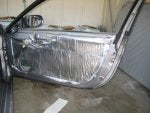I Just got done installing B-Quiet sound insulation in my 2000 Insight. The noise was making me crazy....I am a little less crazy now. First, the instructions on this sight explaining how to remove the door panels are right on! Don't worry about it, just follow the instructions exactly how they are written. I had no broken clips or misfit panel when done.
I am an Audiologist and have a good sound level meter I used to take the following readings.
Before the install of B-Quiet in the doors and in the rear well, the sound level reading are as follow. All measurements are in dBA, the correct setting for the sound level meter.
Before the B-Quiet:
At 30 mph it was 70dB at my right ear in the cabin
At 55 mph it was 79 dB """"" """"""
" 65 mph "" '' 75 db
" 73 mph it was 78 dB
It was over 80 dB hitting bumps
================================
After the B-Quiet install
At 30 mph it was 63 dB
At 55 mph it was 74 dB
At 65 mph it was 72 dB
At 73 mph it was 76 dB
So....it can be seen that B-Quiet does help some with the cabin noise. It appears to help the most at lower speeds and can be subjectivly notice at the lower speeds. At higher speeds, it seems harder to notice. I also stuffed "eggcrate" foam in the viod at the right of the well when standing in the back of the car looking forward, as well as around the spare tire. I also bought a cargo mat and intalled it over the rear cargo area. I did not insulate the surface behind the seats or the floor as I read this makes little difference. Please let me know it this is so. I bought 50' of B-Quiet and have over half of the roll left.....so.....buying 2, 12' rolls is enough to do the job I show here. You do not need the 50' roll......
Now....I have 50 psi in all tires and the reading are subject to different types of road surfaces. On smooth asphalt it is much quieter than on the rough, older grooved roads. Most reading were taken on the rough roads.
I have attached some pictures....I look forward to any comments on my job or on tip on how to further improve the dB level in the cabin.
I am an Audiologist and have a good sound level meter I used to take the following readings.
Before the install of B-Quiet in the doors and in the rear well, the sound level reading are as follow. All measurements are in dBA, the correct setting for the sound level meter.
Before the B-Quiet:
At 30 mph it was 70dB at my right ear in the cabin
At 55 mph it was 79 dB """"" """"""
" 65 mph "" '' 75 db
" 73 mph it was 78 dB
It was over 80 dB hitting bumps
================================
After the B-Quiet install
At 30 mph it was 63 dB
At 55 mph it was 74 dB
At 65 mph it was 72 dB
At 73 mph it was 76 dB
So....it can be seen that B-Quiet does help some with the cabin noise. It appears to help the most at lower speeds and can be subjectivly notice at the lower speeds. At higher speeds, it seems harder to notice. I also stuffed "eggcrate" foam in the viod at the right of the well when standing in the back of the car looking forward, as well as around the spare tire. I also bought a cargo mat and intalled it over the rear cargo area. I did not insulate the surface behind the seats or the floor as I read this makes little difference. Please let me know it this is so. I bought 50' of B-Quiet and have over half of the roll left.....so.....buying 2, 12' rolls is enough to do the job I show here. You do not need the 50' roll......
Now....I have 50 psi in all tires and the reading are subject to different types of road surfaces. On smooth asphalt it is much quieter than on the rough, older grooved roads. Most reading were taken on the rough roads.
I have attached some pictures....I look forward to any comments on my job or on tip on how to further improve the dB level in the cabin.






